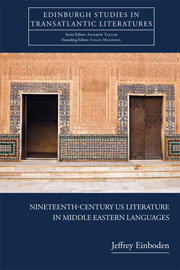Book contents
- Frontmatter
- Contents
- Acknowledgments
- Dedication
- Introduction
- Part I Scriptural Circulations
- Part II Orienting the American Romance
- 3 Inscribing the Persian Letter: Hawthorne and Sīmīn Dāneshvar
- 4 Navigating the Arabic Whale: Melville and Iḥsān 'Abbās
- Part III ‘I too am untranslatable’: Middle Eastern Leaves
- Notes
- Bibliography
- Index
3 - Inscribing the Persian Letter: Hawthorne and Sīmīn Dāneshvar
from Part II - Orienting the American Romance
Published online by Cambridge University Press: 05 October 2013
- Frontmatter
- Contents
- Acknowledgments
- Dedication
- Introduction
- Part I Scriptural Circulations
- Part II Orienting the American Romance
- 3 Inscribing the Persian Letter: Hawthorne and Sīmīn Dāneshvar
- 4 Navigating the Arabic Whale: Melville and Iḥsān 'Abbās
- Part III ‘I too am untranslatable’: Middle Eastern Leaves
- Notes
- Bibliography
- Index
Summary
The literary landscape of Iran shifted seismically in 1969 with the appearance of Sīmīn Dāneshvar's Sūvashūn, the story of one family's trials during British occupation in the final years of World War II. Not only the first novel published by a woman in Iran, Sūvashūn was also to become an Iranian best-seller, still celebrated as the most widely sold novel in Persian literary history, enjoying a ‘circulation of over half a million’ and meriting at least twenty reprints. Fictional mirror of political history, Sūvashūn blends ancient myth and modern fact, accenting the romantic, fantastic and tragic elements of Iranian life under British rule. Centred on its solitary heroine – Zari – the novel explores, in particular, the labyrinthine psychology of repression, shame and secrecy engendered by this crisis in Iran's national consciousness, culminating in the martyrdom of Yusuf – Zari's activist husband – and her subsequent struggles to remember and persevere.
Considering the style and subject of Sūvashūn – its blend of history and fiction, its wounded, yet resilient, female protagonist – it is perhaps not insignificant that Sīmīn Dāneshvar had opened her career, fourteen years earlier, by producing a Persian translation of The Scarlet Letter. Classic tale of sin and secrecy, of national founding and personal tragedy, Hawthorne's own Romantic novel – focused on the wounded, yet resilient, Hester Prynne – likely attracted Dāneshvar's notice during her tenure as a Fulbright scholar in the United States. Studying creative writing at Stanford between 1952 and 1954, Dāneshvar worked under Wallace Stegner, not only novelist of the American West, but also a fellow Hawthornean, responsible for an edition of Twice-Told Tales in 1966.
- Type
- Chapter
- Information
- Publisher: Edinburgh University PressPrint publication year: 2013



